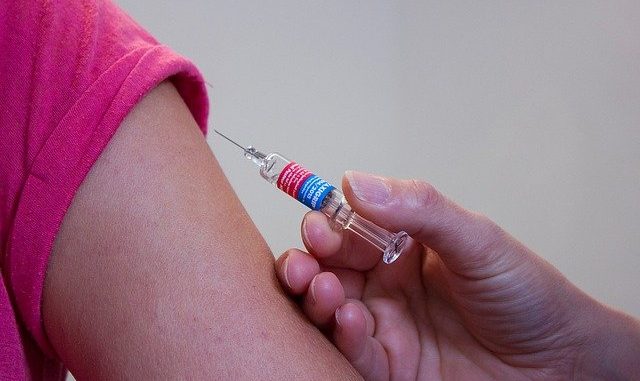
Vaccines are an important weapon in the armoury for minimising disease impact in the human race. A vaccine is a biological preparation that improves immunity to a particular disease. It is an agent that contains elements that represent or resemble a disease-causing microorganism which stimulates the immune system to recognise foreign agents and so ward off damaging diseases.
The idea of vaccination begins with the Gloucestershire born physician Edward Jenner who in 1796 had recognised that girls who milked girls did not suffer from smallpox although they may have had the less serious disease, cowpox. The cow pox virus known as variola vaccinia was found to confer protection from smallpox because it had in some way stimulated the body to protect itself from the more damaging disease. Almost a century later, two French microbiologists Louis Pasteur and Emile Roux produced the first vaccine against another deadly disease called rabies.
Vaccines and immunization are an active component in setting up the immune system to deal with foreign substances especially bacteria and viruses as we explain elsewhere too.
Types Of Vaccines
Vaccines are dead or inactivated organisms or products derived from them. Kuby, in his book on Immunology identifies several different types of vaccine. We find:-
- Whole organism vaccines which are either killed or attenuated which means they are deactivated and lose their ‘deadly’ activity.
- Purified macromolecules from a microorganism. These can be toxic agents, often called toxoids, such as the pertussin toxin from Whooping Cough, capsular polysaccharides found on viruses, and recombinant microbial antigens or surface antigens.
- DNA vaccine
- Recombinant vaccine
- Multivalent subunit vaccines
Vaccines do not guarantee complete protection from a disease. Sometimes they need an adjuvant. This comes from the latin word, adiuvare which means ‘to aid’ and is also the stem of the word ‘adjudicate’ and ‘adjutant’. Adjuvants are pharmacological and immunological agents that modify the effects of other agents such as drugs or vaccines. they need to be added to enhance the recipient’s immune response to a supplied antigen, whilst keeping the injected foreign material to a minimum.
Immunization
It’s worth mentioning immunization because that’s important in understanding the principle of vaccination. Immunization is defined as the procedure by which the body is made redy to fight against a specific disease. It is used to induce the immune resistance of the body to a specific disease. Immunization takes two forms;
- Passive immunization.
- Active immunization.
Passive immunization or immunity is produced without challenging the immune system of the body. It occurs by administering serum or gamma globulins from a person who has already been immunized and who may have been affected by the disease of interest to a non-immune person.
Toxoids
A toxoid is a substance which would normally be toxic. It has been processed to destroy its toxicity and retains its ability to induce antibody production through the immune system. A toxoid is thus a reduced and weakened component that would be secreted by various pathogens. These toxoids are also used to develop immunity against common diseases like tetanus, diptheria and cholera.
Passive Natural Immunization
The case when a mother passes on her immunity to her child before and after birth. before birth, immunity is transferred from mother to the fetus in the form of maternal antibodies which are mainly Immunoglobulin G via the placenta. After birth, various antibodies such as immunoglobulin A are transferred through breast milk.
Passive Artificial Immunization
Artificial immunization is obtained by injecting previously prepared antibodies using serum from humans or animals. Immunity of this type provides an immediate protection against various acute infections such as measles, rabies and tetanus.
Acute Immunization
Active immunization is acquired by activating immune system of the body. Active immunity is obtained naturally or artificially. The body develops a resistance against disease by producing antibodies following exposure to antigens.
Active Natural Immunization
A naturally acquired active immunity requires activation of the body’s immune system so that it produces antibodies. It occurs with clinical and subclinial infection.
Active Artificial Immunization
This type of immunization requires challenging the body with toxoids and vaccines.
Recombinant Vector Vaccines
These types of vaccines are experimental and operate in a manner which is similar to DNA vaccines. It uses an attenuated virus or bacterium that introduces microbial DNA into cells of the body. The vector is bacterium or virus which is used as a carrier.
DNA Vaccines
This approach involves taking genes from a microbe which produces antigens of interest that are then introduced into the body. In this approach some of the recipient’s cells take up that DNA. This DNA then instructs the cells to produce antigen molecules. These cells secrete the antigens which are then presented and displayed on their cell surfaces. It turns the body’s own cells into natural vaccine producing systems which help to stimulate the immune system.
Routes To Administration Of Vaccines
Artificial immunization can be obtained by many routes. It often involves deep subcutaneous or intramuscular routes. Other routes include via mouth (oral) as with the oral BCG vaccine. The BCG vaccine can also be administered through an intradermal route. The small pox vaccine is given by scarification where the skin is scratched. The fifth route is intranasal as with administrating live attenuated influenza vaccine.
Leave a Reply